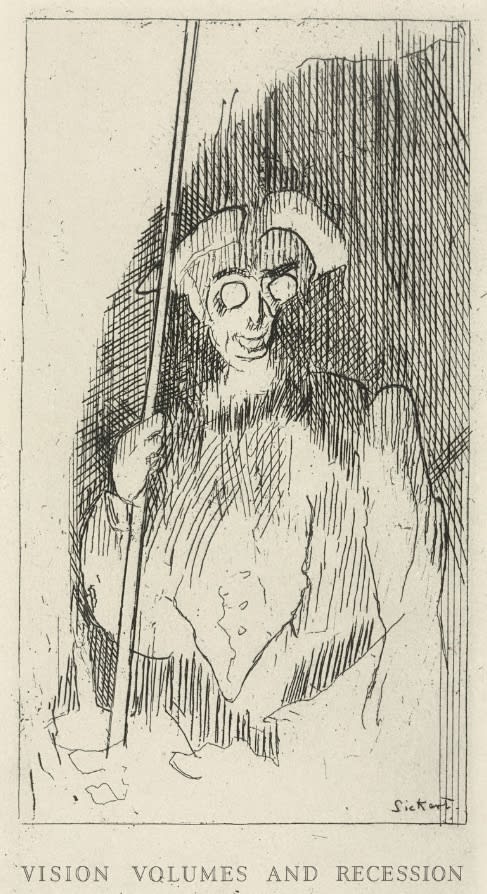For Walter Sickert, a little spring sunshine was a fine thing and not to be wasted. Deep shadows helped him to suggest the brightness of daylight.
InSight No. 125
Walter Sickert, St Rémy: Chevet de l'Eglise, 1913
According to a popular vote organised in 2020 by the French television station TF1, Dieppe’s Saturday market is the finest in all France. Notable produce available to purchase there includes scallops, cider, and a crumbly cheese from nearby Neufchâtel-en-Bray. Walter Sickert (1860–1942) was well acquainted with the fruits de mer that came ashore daily from the boats of the town’s fisherfolk, and he might have been pleased to think that Dieppe would still be thriving more than 140 years after he came to know it. He was familiar with the town from childhood, lived there for an extended period between 1898 and 1905, and painted its dusty roads, glamorous casino gardens and dirty public buildings in a period that extended over four decades.

St Rémy is the lesser of two grand churches in Dieppe. Although he made scenographic renderings of San Marco in Venice and the larger Dieppe church St Jacques, Sickert preferred to characterise St Rémy by painting awkward interstices and partial views. In two paintings from 1913/14, he pictured the steeply glanced chevet (or ‘head’) beside the branches of a neighbouring chestnut tree.

The Sickert specialist Wendy Baron has catalogued no fewer than fourteen paintings of St Rémy by Sickert, most of which use similarly restricted elevations. It is a rambling church, constructed over a protracted period from roughly 1522 to 1630 and hemmed in tightly by neighbouring buildings, and the artist’s pictures speak to the building’s jumbled fabric and confined urban situation.

The composition of St Rémy: Chevet de l'Eglise reveals a narrow slice of soot-darkened stonework and a roughly indicated parapet of gargoyle run-offs. Sickert had learned about ‘the cut’ from Degas and the Impressionists in the 1880s, and he spent his career exploring the wide range of pictorial effects that could be achieved by cropping a subject at the edge of the picture surface, thereby drawing attention to the tableau, making a familiar subject strange with a curious emphasis, and much besides. Writing in 1910, Sickert wrote of the Impressionists that:
They have shown us that composition has infinite possibilities, infinite permutations and combinations other than those already found by the old masters. In this discovery their chief guide was nature. But their research was greatly stimulated and sharpened by the importation of certain works from the Far East.
Using a characteristically colourful metaphor, Sickert described how the Impressionists ‘went on with their own business, like a cobra who has swallowed a goat, goes quietly on with his own business of being a cobra with the goat inside him.’ That particular goat was inside Sickert too, and his paintings of architectural subjects reflect this.

For most of Sickert’s career, his paintings wove together areas of colour to create a relationship of light and shadow. He refined this tonal method, making pictures with an artfulness that some critics considered superficial or contrived. In 1911, his friend Roger Fry wrote of Sickert:
The perfection and refinement of his taste is evident in the exquisite choice, none the less perfect that it seems to be half-unconscious, of the few tones of violet-grey, dull maroon, orange, and green, out of which he builds his colour schemes. I can imagine him saying that he painted what he saw, but it is evident that a process of readjustment of all the tones takes place, whereby all sudden and sharp contrasts are eliminated and each tone takes its relative place in the peculiar sombre scheme which is personal to the artist.
Few other critics at the time could have evoked so accurately the craftsman-like ingenuity of Sickert’s tonal method.

However, in panel paintings such as St Rémy: Chevet de l’Eglise, painted two years or so after Fry wrote his review, Sickert demonstrated a keen attentiveness to effects of light and atmosphere and a disciplined concern for the subject studied from nature. In this particular work, the church is pictured contrejour against blinding spring sunshine. The rooftops and chimney stacks to one side glow with reflected daylight. The place where the church touches light and air – the circumambient atmosphere – is convincingly naturalistic. Notwithstanding Fry’s remark about a ‘process of readjustment’, Sickert’s pictures often convey the vitality of their subject even as they accommodate it within an exquisitely calculated artifice of colour and design.

Images:
1. Walter Sickert, St Rémy: Chevet de l'Eglise, 1913, oil on panel, 10 x 6 in
2. Postcard of pêcheurs de crevettes, Dieppe, circa 1880
3. The church of St Rémy, Dieppe
4. Walter Sickert, The Elder Tree, Dieppe, circa 1914, Private Collection
5. Hiroshige, Plum Park in Kameido, 1857, Rijksmuseum, Amsterdam
6. Walter Sickert, Vision, Volumes and Recession, 1924, Museum of Modern Art, New York
7. Walter Sickert, St Rémy: Chevet de l’Eglise

